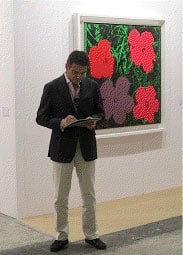Establishing an International presence at Art Hong Kong
Asia’s Leading Modern and Contemporary Art Showcase In Review

Art Hong Kong, while a lucrative venture for local galleries featuring works by prominent contemporary Chinese artists, remains considerably less profitable for international galleries wishing to sell to local buyers.
Traditionally, non-local galleries have faced difficulties establishing themselves at Art HK. I spoke to agents of galleries which had participated in earlier editions of the fair. They admitted to selling very little to Chinese collectors prior to this year. It seems that trophy hunting has become very important, and what better place to come into possession of a trophy than in public, at an auction?
Buyers spent $106 million on wine and modern paintings, and $97 million at the 20th Century & Contemporary Asian auction at the week-long Hong Kong sales. The sales were 82% sold by lot and 94% sold by value. Eighteen world auction records were achieved for a broad range of works, including twelve lots by Chinese artists. Prices eclipsed projected estimates on both ends of the scale. Lavish catalogues featured hundreds of works. Works by some quite unknown contemporary Chinese artists sold for millions. The first fine arts auction houses to arrive in Hong Kong, Christie’s and, soon after, Sotheby’s, had quite some time to corner the market ahead of the galleries.
In bringing pieces for sale at Art HK, many galleries played it safe. Warhol and Picasso dominated the fair. Popular contemporary artists included Murakami, Nara, Hirst, Quinn, Koons, Basquiat, Indiana, Condo, and Botero. To see a Richter or an Orozco was actually a relief. Some large galleries, such as Pace or Aquavella, brought works by one or two token Chinese artists along with their fancy inventories in order to fit in with local dealers.
Several galleries and dealers from Europe and the U.S. have already established themselves in China. The most notable include the Gagosian Gallery, Ben Brown, Beijing’s Pace, and Eduoard Malingue, son of legendary dealer Daniel Malingue. Admittedly, even these established dealers have made very few sales to locals, but they are optimistic about increased local sales as the market matures and Art HK settles in with new partners Art Basel in coming years.
Art HK was, for the Artemundi Global Fund, not a bad place to be. As the Chinese were not, for the most part, buying from international galleries, these were in turn more willing to cut deals on the works they had shipped to the fair at great expense. Much digging was necessary: most of the works for sale were not high-quality, had been traveling from fair to fair around the globe without selling, and made for poor potential investments. We managed to find a lovely Picasso and began negotiating for a prime Pollock not present at the fair, amidst picking some emerging art for the Adrastus Collection.
For Chinese buyers, and for our Cayman-based fund, it may be a wise business decision to choose to buy works from Art HK and store them at the Singapore Freeport for the next few years, until the market matures.
By my estimation, the three safest blue-chip works at Art HK were the Giacometti head life-cast 2/6 priced at $2.5 million (Lelong), Andy Warhol “Flowers” at $7 million (Cheim & Read), and the exquisite 1952 Philip Guston abstract canvas at $3 million (Acquavella).
Art Basel, the new partners behind Art HK, must reshape this fair to encourage locals to buy outside the local art economy if they wish to ensure international galleries’ participation in future editions of Art HK. I suggest they do as Art Basel Miami Beach: bring in buyers from well beyond the local art scene.

